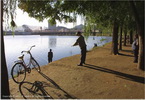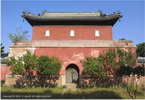|
 |
CHENGDE 承德市 |
|
GPS: |
40.95066,
117.97709 |
|
Chengde was established by
Qing-dynasty emperor Kangxi as
the imperial summer residence.
The city’s core remains of the
18th-century . It houses, beyond
its walls, 8 main Buddhist
temples. |
|
|
| |
|
|
|
|
|
| |
Chengde Imperial Summer Villa
避暑山庄 |
|
GPS: |
40.9889,
117.94415 |
|
Built between 1703 and 1792
during the Qing dynasty, the
Mountain Resort took 89 years to
complete. It covers a total area
of 5.6 square kilometres (2.2 sq
mi), almost half of Chengde's
urban area. It is a vast complex
of palaces and administrative
and ceremonial buildings.
Temples of various architectural
styles and imperial gardens
blend harmoniously into a
landscape of lakes, pastureland
and forests. |
 |
|
|
|
|
|
|
|
Puning Temple
(Temple of Universal Peace)
普宁寺 |
|
GPS: |
41.01527,
117.95232 |
|
The Puning Temple (Temple of
Universal Peace) was modeled
after the Samye Monastery, the
sacred Lamaist site in Tibet.
The front temple was constructed
in the Chinese style, although
the temple complex follows both
Chinese and Tibetan
architectural styles. The Puning
Temple houses the world's
tallest wooden sculpture of the
Bodhisattva Avalokiteśvara
(22.28-meter-high and 110 ton). |
 |
|
|
|
|
|
|
|
Pule Temple (Temple of Universal Joy)
普乐寺 |
|
GPS: |
40.99734,
117.96228 |
The Temple of Universal Joy
(Pule Temple) lies on the
hillside, two kilometers to the
east of the Wulie River in
Chengde City.
It is commonly
called "round pavilion". The
temple was built against the
terrain and the door of the
temple is facing west, meaning
that Buddhist door is facing
Western Ultimate World. The door
faces west also because the
Mountain Summer Resort of Qing
Dynasty is in the west. |
 |
|
|
|
|
|
|
|
Putuo Zongcheng Temple
普陀宗乘之庙 |
|
GPS: |
41.01468,
117.9332 |
|
Putuo Zongcheng Temple is one
part of Eight Outer Temples in
Chengde, Build during the reign
of the Qianlong Emperor, the
temple was modeled after the
Potala Palace of Tibet. Tthe
temple represents a fusion of
Chinese and Tibetan
architectural styles. Many of
its halls and pavilions are
adorned with copper and gold
tiled roofs, adding to the
splendor of the site. |
 |
|
|
|
|
|
|
|
Xumi Fushou Temple
(Temple of Happiness and
Longevity)
须弥福寿之庙 |
|
GPS: |
41.01137,
117.9421 |
|
The Xumi Fushou Temple (Temple
of Happiness and Longevity) is
one of the Eight Outer Temples
in Chengde. The temple covers an
area of 37,900 square metres.
The temple was first designed in
1780 to celebrate the 70th
birthday of the Qianlong
Emperor. It was built for
Penchen Lama the VI who came to
Chengde from Tibet to convey his
congratulations and is a fusion
of Chinese and Tibetan
architectural style. |
 |
|
|
|
|
|
|
|
Anyuan Temple (Temple of Distant
Peace)
承德市安远庙 |
|
GPS: |
41.00438,
117.96086 |
|
Anyuan Temple (Temple of Distant
Peace) is one of the Eight Outer
Temples of Chengde. It was built
in 1756 by Emperor Qianlong
following his victory over the
Dzungar people of Outer
Mongolia. |
 |
|
|
|
|
|
|
|
Bangchui Shan (The
Sledge Hammer Peak)
磬锤峰 |
|
GPS: |
41.00091,
117.97912 |
|
The Sledge Hammer Peak is an
impressive rock formation
located outside Chengde. It is a
nice example of a Danxia
landform. Around Chengde City
there is a kind of peculiar
landform. That is formed through
long time geological process,
which features red rocks. |
 |
|
|
|
|
|
|
|
Chengde (Others) |
|
GPS: |
N/A |
|
N/A |
 |
|
|
|
|
|
|
|
Tai Chi Chuan
太極 |
|
GPS: |
N/A |
|
Tai chi is an internal Chinese
martial art practiced for both
its defense training, its health
benefits and meditation. The
term taiji is a Chinese
cosmological concept for the
flux of yin and yang, and 'quan'
means fist. So etymologically,
Taijiquan is a fist system based
on the dynamic relationship
between polarities (Yin and
Yang). |
 |
|
 |
JINSHANGLING great wall
金山岭长城 |
|
GPS: |
40.68246,
117.24349 |
|
WJinshanling is a section of the
Great Wall of China located in
the mountainous area in Luanping
County, Chengde City, Hebei
Province, 125 km northeast of
Beijing. This section of the
wall is connected with the
Simatai section to the east.
Some distance to the west lies
the Mutianyu section. |


 |
|
|
|
 |
SIMATAI
great wall
司马台长城 |
|
GPS: |
40.65483,
117.27777 |
|
Simatai Great Wall was built
from 1368 to 1398 in the early
Ming Dynasty. It stretches from
"Viewing Beijing Tower" in the
east and to the Houchuankou in
the west. It is the only ancient
Great Wall that preserves the
original appearance of the Great
Wall of the Ming Dynasty. Later,
from 1465 to 1487, in order to
strengthen the defense, the
Great Wall has been renovated
and extended. |


 |
|
|
|
 |
HEBEI
COUNTRYSIDE |
|
GPS: |
N/A |
|
N/A |
|
|
|
| |
|
|
|
|
|
|






















